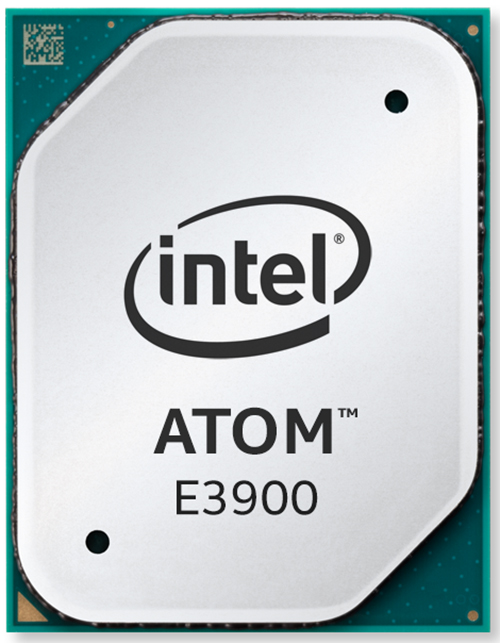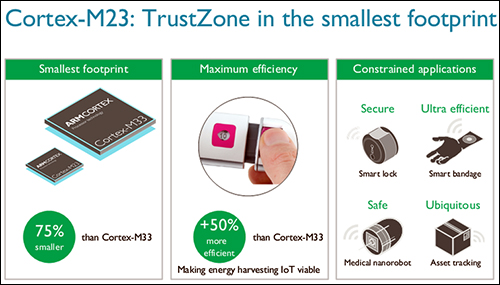Intel’s E3900 Series SoCs Aimed at Industrial, Computing-Intensive Applications
Yesterday, chipmaker Intel announced a new series of Atom processors called the E3900 series, which offer up to 1.7 times the computing power and up to 2.9 times better 3D graphics performance than its previous Atom series (E3800), which was released during the fourth quarter of 2013. The E3900 chips can also manage more sensors and operate at a wider temperature range than the E3800 series.
Each processor, or system-on-a-chip (SoC), contains a dedicated security processor that supports a feature called the Intel Trusted Execution Engine 3.0. This enables a number of security features, including a secure booting process designed to prevent malware or other unauthorized software from accessing the processor’s firmware or operating system.
“When we started to design E3900, which was purpose-built for IoT applications, we focused on vertical solutions,” says Ken Caviasca, the VP of Intel’s IoT Group, “and then went to use cases and technology specifications that we’d need for the silicon.”
Those verticals that Intel is eyeing with each new processor are automotive, industrial, digital security and surveillance, manufacturing and retail. For industrial, security and retail applications, those use cases are edge computing, particularly those for which events are precisely timed. That is because the E3900 series uses what Intel calls its Time Coordinated Computing technology, Caviasca explains, which synchronizes clocks inside the chip and across the network to support highly accurate synchronized computing, down to 1 microsecond of accuracy.
For example, a maker of programmable logic controllers used at a manufacturing plant might use an E3900 series chip to handle the tightly synchronized movements of networked robotic arms. The chips’ advanced image-processing features and processing power make them applicable for IP-based video cameras, by supporting on-camera analysis so that only relevant data is passed on to cloud-based applications. (In the automotive space, the targeted use cases that Caviasca references are not related to connected-car or IoT applications, but rather to graphics and processing needs for cockpit computers and infotainment applications.)
The E3900 series microprocessors—which are available in three stock-keeping units (SKUs) that range from 6.5-watt to 12-watt thermal design power (thermal output)—is expected to be made available during the first quarter of next year.
ARM Expanding Security Capabilities to Small IoT Devices
U.K.-based chip designer ARM Holdings, whose processor designs, licensed by many brands including Samsung and Qualcomm, are used in more than 95 percent of the world’s smartphones, announced two new chip designs—the Cortex M-23 and Cortex M-33—yesterday at its TechCon conference. Both chips are exceptionally small, the company reports: the M33 measures one-tenth of a square millimeter, while the M-23 is 75 percent smaller than the M33. The M-23 is also 50 percent more energy efficient than the other model.
While the M-33 is suitable for use in smart watches or for managing sensor networks utilized in smart-city applications, such as street lighting, the M-23, given its smaller size and lower energy requirements, could be designed to harvest radio frequencies emitted from a gateway or reader, rather than requiring an on-board battery. This would open up a number of applications, the firm reports, including bandages that contain sensors used to transmit data about a patient, or in asset tracking applications in which a label with an integrated sensor can transmit data regarding temperatures during transit.
Given recent security breaches involving IoT devices, the news that these two new chip designs are intended to be licensed and implemented along with ARM’s ARMv8-M architecture—which includes ARM’s design for security chip, the TrustZone CrytoCell, and its mbed operating system—will likely come as welcome news to end users. The ARMv8-M architecture also includes ARM’s Cordio radio, which supports Bluetooth Low Energy (BLE) and IEEE 802.15.4 (ZigBee) connectivity. CrytoCell and Cordio are optional, however, and it is up to the licensee to integrate them.
ARM also said it will roll out its first software-as-a-service offering, a cloud-based mbed operating system. Michael Horne, ARM’s VP of marketing and sales, says the solution will allow original equipment manufacturers to provision and secure an IoT device using chips based on AMR’s Cortex-A or Cortex-M series, on any network, and on multiple clouds. This service will be subscription-based and will be available during the first quarter of next year.
SoftBank, a Japanese provider of telecom and internet services, acquired ARM Holdings last summer for $32 billion. According to ARM, seven chipmakers—Analog Devices, Microchip, Nuvoton, NXP Semiconductors, Renasas, STMicroelectronics and Silicon Labs—have already signed licensing agreements for the M-33 and M-23.



